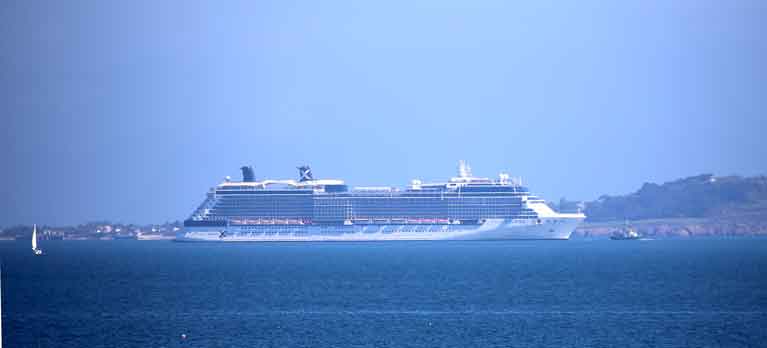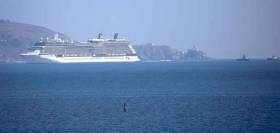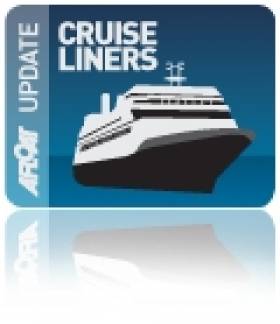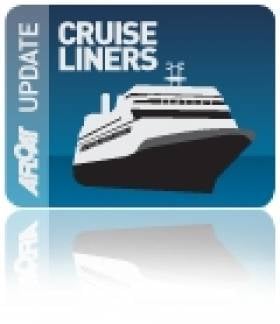Displaying items by tag: Celebrity Eclipse
Luxury cruise liner Celebrity Eclipse made her maiden call to Dublin Port this morning.
As our photo above shows Dublin Port Pilots and two Port Tug boats escorted the liner on her first journey past the Baily Lighthouse in the north of the Bay.
The 2,850-passenger Solstice Class ship is 313 m long.
Shortly, after the above photo was taken the ship turned through 180 degrees to allow her reverse up in to her River Liffey berth in Dublin city as pictured below.
 Celebrity Eclipse prepares to reverse into her River Liffey berth from Dublin Bay
Celebrity Eclipse prepares to reverse into her River Liffey berth from Dublin Bay
Passengers were greeted on arrival to the sights and sounds of a Celtic themed welcome spectacle of music and dance before disembarking for a day of shopping, sightseeing and exploring in the capital. Among the passengers are President and CEO of Celebrity Cruises, Lisa Lutoff-Perlo, and a delegation of 400 cruise industry leaders who will enjoy a VIP guest experience in Dublin during their call.
Having arrived from Cobh, the Celebrity Eclipse will depart Dublin again at 10.30pm today to spend two days at sea before arriving at her next port of call, Akureyri, Iceland, as part of the ship’s 12-day itinerary touring the UK, Ireland and Iceland.
Offering guests a modern luxury experience, the ship features a choice of 13 restaurants and cafes and one of the largest wine collections at sea. This is in addition to a spa and solarium, the celebrated Lawn Club including half an acre of real grass lawn on the top deck, hot glass blowing demonstrations, swimming pools, casino, theatre, boutique shopping, basketball court, art gallery, library, internet café, portrait studio and Suite Class accommodation with butler service, which are just some of the amenities on board the 17-deck luxury liner.
Celebrity Eclipse will return to the city in 2018 when she becomes the first ship of a major cruise line to call Dublin Port a ‘home port’. She will be based in Dublin Port for a mini-season of holidays to Northern Europe next year, with over 14,000 people expected to begin their holiday from Dublin Port in 2018. The development is worth an estimated almost €6 million to Dublin and the surrounding area in knock-on economic benefits. Dublin Port Company has already established Cruise Dublin to promote the interests of local businesses to international cruise lines and their passengers.
This year, Celebrity Eclipse is among the increasing number of longer cruise ships requesting to call at Dublin Port. Of the record number of cruise calls scheduled this year, seven ships measure longer than 300m, pushing the boundaries of the port’s operational limits.
Such is her length, Celebrity Eclipse had to manoeuvre into Dublin Port ‘stern first’, i.e. in reverse this morning. Ships greater than 300m in length cannot turn within Dublin Port and are therefore brought stern first (reversed) up the River Liffey. This complex manoeuvre will no longer be necessary once Dublin Port’s Alexandra Basin Redevelopment (ABR) Project is complete. Larger, longer ships will then be able to routinely call at the port and turn within the expanded Alexandra Basin West and berth further upriver, closer to the city at the Tom Clarke Bridge. The planned redevelopment is expected to result in an extra 600,000 tourists for the city annually, three times current visitor levels.
Pat Ward, Head of Corporate Services, Dublin Port Company, said:
“We are delighted to welcome Celebrity Eclipse on her maiden call to Dublin Port as we kick-start a record cruise season for 2017. With 130 cruise calls scheduled, it’s shaping up to be a busy season with thousands of passengers and crew set to explore the sights and sounds of the city. Ten of this year’s cruise calls are maiden voyages, confirming Dublin Port and Dublin City’s growing appeal as a marquee destination on the itineraries of the world’s leading cruise lines.
“We are also looking forward to Dublin Port becoming a home port to a major cruise line next year, and to growing this valuable business for the city. An estimated 90% of turnaround passengers will fly into Dublin to pick up their cruise, creating demand for extra bed nights in the city and discretionary spend for the city’s retail outlets and visitor attractions. And unlike port of call, homeporting passengers typically spend three to four days either side of their departure or arrival date exploring the home port city and surrounding counties. With more free time to explore, home porting has strong potential to benefit both the city and regional economies.”
Jo Rzymowska, Vice President and Managing Director Celebrity Cruises, UK & Ireland and Asia, said:
“It is now only one year to go until we become the first major cruise line to homeport from Dublin when Celebrity Eclipse will call the city home for a mini season from April 2018. We are continuing to work with our partners at Dublin Port Company to ensure that we offer efficient check-in and smooth disembarkation experiences for all of our guests. This is a very exciting investment for us and we are thrilled with the level of support and enthusiasm from the people and businesses of Dublin ahead of our arrival into the city next year.”
#CobhCelebrity – Cobh welcomed Celebrity Eclipse this morning as the giant luxury ship made a first port of call having set off from Southampton, the UK’s largest cruiseport, writes Jehan Ashmore.
The ‘Solstice’ class 121,000 gross tonnage luxury cruiseship at 317 metres in length is impressive given that the quay at Cobh Deepwater Berth is only 33 metres longer. It is also the only facility in Ireland in which the Port of Cork can offer a dedicated cruise berth. Planning permission however in recent years was granted for a cruise terminal in Dublin where tomorrow the ship is due to make a maiden port of call to the capital.
The 2,850 passenger capacity Celebrity Eclipse is the third of a quartet built in Germany for US based owners Celebrity Cruises. In what is a very unusual feature to be found on board is the 'Hot Glass Show'. This is where the fascinating art of glass-blowing is performed by talented craftsmen working in an outdoor studio located on the top deck's Lawn Club.
The 16 passenger deck ship was ranked among the Top 20 Large Cruise Ships according to Conde Nast Traveler's 2014 Reader's Poll. Four years previously, Celebrity Eclipse made a maiden call to Cobh. The occasion also celebrated the 500th visit of a cruiseship to Cobh, which was covered for a report published in Ships Monthly, July 2010 issue.
Notably, this first call to Cobh of the then new cruiseship took place only days after assisting stranded UK holiday makers in Spain following the Icelandic volcanic ash cloud crisis caused by the eruption of Eyjafjallajökull. This led to widespread disruption due to a complete shut-down of aviation travel across Europe.
In an 'act of goodwill' the owners deployed Celebrity Eclipse to make a special round trip in April 2010 from Southampton to Bilbao. This involved transporting 2,200 tourists back home on a passage across the Bay of Biscay.
Cobh Cruiseships Come and Go (Footage)
On Friday the Port of Cork welcomes another large cruiseship in the form of the Emerald Princess which carries 3,592 passengers, nearly 500 more than the Celebrity Eclipse. The 113,000 tonnes vessel is nearly 950-feet long, is 118 wide and draws 28 feet under the waterline. With 19 decks the vessel towers above the oceans and will also do so when alongside Cobh's 350m deepwater berth.
One of the numerous amenities onboard is the CyberGolf link and jogging track which are located high up near the stern. Directly situated below is the Skywalkers Nightclub and for movie-goers, films are shown at an oudoor theatre. The top of the range cabins are the 900 balcony staterooms which offer first class hotel style 24-hour room service.
A First for Cobh as Two Cruise Giants Come and Go
In an unprecedented scheduling of cruiseships to the Port of Cork (Cobh), the inbound Independence of the Seas (154,407 tonnes) the largest cruiseship to call to any Irish port, passed the 122,000 tonnes Celebrity Eclipse which was preparing to depart from the town's cruise terminal.
Some 15 minutes later Celebrity Eclipse pulled away from the berth. During that timeframe the Independence of the Seas had completely turned around in the opposite direction to face Cobh after maneuvering in the swinging basin between Cobh and the Naval Base on Haulbowline Island.
The 4,175-passenger Independence of the Seas is the third of the 'Freedom' class vessels. She has a length of 339m and is a mere 11m shorter in distance to that of the 350m berth at Cobh. The 38m wide cruiseship has a draft of 8.7m and the depth of water at the town's quayside is 9.1m.
The 15-deck vessel was built by Aker Finnyards in Turku, Finland in 2008 for Royal Caribbean International (RCI). Amenities on the Freedom class consist of the an innovative surf park, canitilevered whirlpools, ice-skating rink, full-size boxing ring and a H2O Zone waterpark.
As for the 3,179-passenger Celebrity Eclipse, she is the second of five 'Solstice' class sisters and measures 317m (length) 48m (beam) and draws 8.6m. On the top deck there is the fresh green grass located at Lawn Club. She was built by the Meyer Werft shipyard in Papenburg, Germany and entered service last year for her owners Celebrity Cruises.
Independence of the Seas departed yesterday afternoon on an overnight passage from Southampton where the vessel is based in the summer and for the winter she is based out of Florida. The Celebrity Eclipse departed the UK south coast port from Cobh where the larger cruiseship is also to make overnight port of call.
In total 10,000 passengers and crew will of visited the Cork Harbour region alone over the May Bank holiday. To meet the surge in demand for the shore-based excusions a fleet of buses awaited and additional trains were also laid-on by Irish Rail. The railway station is located next-door to the Cobh Heritage Centre which retraces the town's strong trans-Atlantic liner era.
- Cobh
- Cork Harbour
- port of Cork
- Independence of the Seas
- Ports and Shipping
- Cobh Cruise Terminal
- Ports and Shipping News
- Cork Harbour News
- Irish Rail
- Celebrity Eclipse
- Port of Cork News
- Aker Finnyards
- Celebrity Cruises
- Royal Caribbean International
- Freedomclass
- Solsticeclass
- MeyerWerft
- Cobh Heritage Centre
Cruise Giants to Meet off Cobh
For the first time two cruiseship giants are scheduled to depart and arrive off Cobh at the same time this May Bank Holiday weekend, writes Jehan Ashmore.
The largest cruiseship to call to an Irish port the Independence of the Sea which weighs 154,407 gross tonnes (some 6,000 tonnes larger than the liner Queen Mary 2) will pass the Cobh-berthed Celebrity Eclipse of 122,000 tonnes around 14.00hrs on Sunday.
Weather permitting the Independence of the Seas will then be maneuvering in the swinging basin between Haulbowline and Cobh, just upriver of the Celebrity Eclipse which will then begin to pull away from the deepwater berth at the Cobh Cruise Terminal.
The 350m long berth has a quayside depth of 9m and is capable of handling some of the largest cruiseships on this island.
Prior to Sunday's sailing spectacle the Celebrity Eclipse is due to dock tomorrow afternoon for the overnight call. Likewise the 4,375 passenger Independence of the Seas will stay at Cobh for an overnight call and then depart's on Monday evening.
“Two such large cruise liners, have never before been in Cork Harbour at the same time, let alone pass each other creating a magnificent sight. An excellent viewing point for anyone planning on visiting Cobh on Sunday 1st May would be the High Road or Whitepoint in Cobh” said Port of Cork Commercial Manager, Captain Micheal McCarthy.
Together the cruiseships will have a combined gross tonnage of nearly 300,000 tonnes and they will bring 10,000 passengers and crew into the Cork region this weekend alone. Celebrity Eclipse is operated by Celebrity Cruises and the Independence of the Seas is run by Royal Caribbean International.
The 3,129 passenger Celebrity Eclipse made her 'maiden' cruise and port of call to Cobh last year following her high profile repatriation voyage from Spain with stranded UK tourists arising from the fallout of the Icelandic volcanic ash-cloud.
On that inaugural ocasion the Celebrity Eclipse which cost €500m became the 500th cruise caller to the Port of Cork where the vessel made an overnight call at Cobh. To see a time-lapse video marking the 500th cruiseship's arrival click here.
Cruise-Callers Set to Start Summer Season
Dublin Port last year had 88 cruisecalls and this number of vessels is to be closely repeated in 2011. One of the calls will be Princess Cruises 3,100 passenger Grand Princess. This was the first cruiseship of over 100,000grt to dock at Dublin which arrived on 31 August 2004 (click for photo on the day) and to read more about the cruiseship industry in Ireland from the IMDO click here.
Outside the capital the following vessels outlined are the first cruiseships to call at other ports in April. The season runs to September, though in recent years occasional calls are still made up to November.
The first cruise-caller at Waterford is Quark Expeditions adventure exploration vessel Ocean Nova. At only 2,118 tonnes the diminutive vessel is only 73m long and equally has the same number of passengers and a crew of 38.
Built in 1992 the polar adventure vessel has an ice-strengthened hull to enable the exploration of the icy waters of Greenland, the Weddell Sea and the Antarctic. A pair of Zodiac craft are provided for shore-landings.
The hosting of the Waterford Tall Ships Race Festival has led to funding of €1.7m from Failte Ireland to upgrade the city-centre's Frank Cassin Wharf. This will allow the large 'A' class tallships to berth and will be a lasting legacy of the festival. The wharf will then be used to berth cruiseships and other marine users. In total the crystal city is to welcome 12 callers to include the Crystal Serenity in July.
Cork is set to welcome 54 cruisecalls to include the return of the Cunard Line's 90,000grt Queen Victoria which made her first call to Cobh last year. The 2007 built vessel has a guest capacity for 2,000. The Cunard flagship Queen Mary is scheduled mid-September.
The deepwater berth at Cobh Cruise Terminal is capable of handling some of the largest cruiseships and which will see the return of the 122,000grt Celebrity Eclipse also in April.
Celebrity Eclipse made her maiden cruise and port of call to Cobh last year following her high profile repatriation voyage from Spain with stranded UK tourists arising from the fallout of the Icelandic volcanic ash-cloud. The 2,850 passenger €500m cruiseship which made an overnight call at Cobh during the May Bank holiday weekend.
From the south to the north at Belfast, the port's first caller on 24 April is the Ocean Nova which makes another appearance on the Irish cruiseship scene.
Belfast Harbour Commissioners have developed the 1km long Stormont Wharf to attract increasingly larger cruiseships to the city. The Ocean Nova's visit will mark over a dozen years since the first cruiseship docked in the northern capital.
In 2011 Belfast is scheduled to accommodate 30 cruise-calls bringing over 50,000 passengers to the city and surrounding environs.


































































